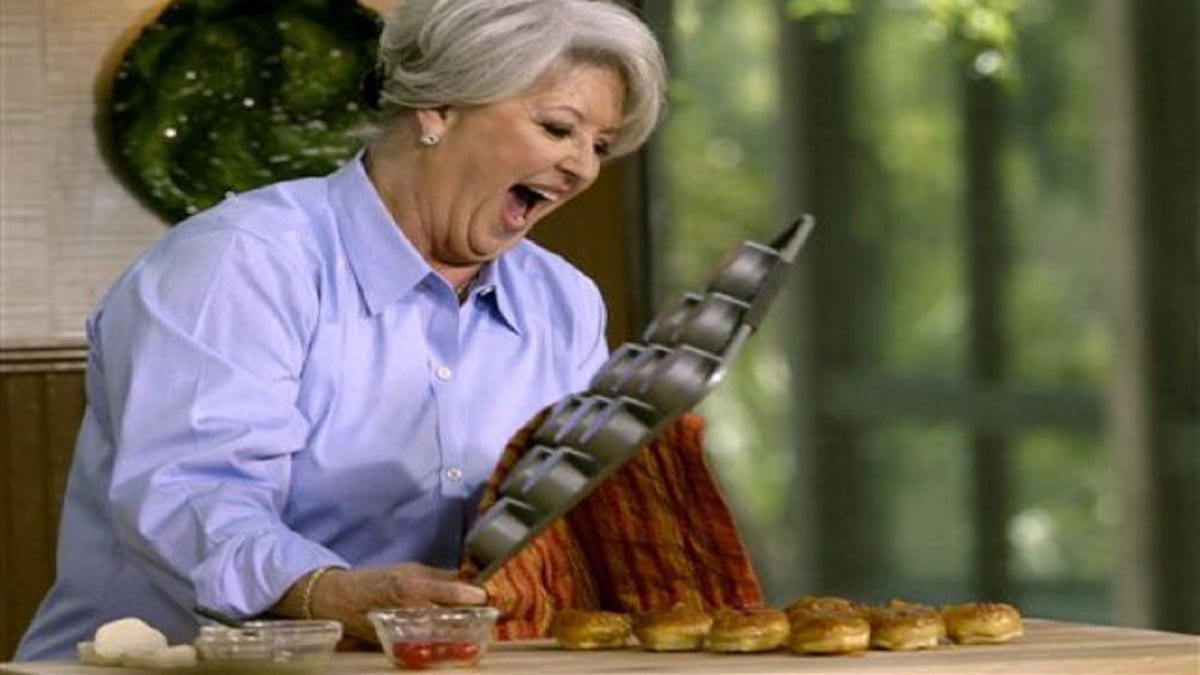
(AP)
“I've always said, ‘Practice moderation, y’all,’' Paula Deen said on NBC's "Today" show after disclosing she has Type 2 diabetes while continuing to dish up calorie-laden recipes on TV. “I'll probably say that a little louder now.”
She’ll say it loud and proud if only to deflect the criticism that’s smothered her like a pork chop in onions since she revealed her diagnosis, held secret for more some three years.
Critics went after the Queen of Butter for revealing her disease only after securing a gig as spokeswoman for the diabetes drug Victoza. Chef and author Anthony Bourdain’s trenchant tweet—“thinking of getting into the leg-breaking business, so I can profitably sell crutches later”—crystallized what many felt. Deen's publicist of nearly six years, Nancy Assuncao, resigned in protest because she couldn't see the logic in her client's decision.
The announcement seemed less about health and more like a naked grab for an even bigger slice of the pie -- which reportedly includes furniture and eyeglass lines and six-figure speaking fees.
“We are a society that kind of believes what’s out there as far as advertising, TV and celebrity,” says Tom Valenti, one of America’s best and most-respected chefs who’s been diabetic for 15 years. “What she does is, to a great extent, entertainment,” he says.
People don’t distinguish between what Food Network celebrity chef does—entertain—and what she does it with—food. She’s an entertainer/celebrity who’s regarded as a food authority because she plays one on TV.
She even admitted as such on the "Today" show when she said cooking in her traditional Southern style is "only 30 days out of 365," she said. "And it’s for entertainment. And people have to be responsible."
A stick of butter in her hands is as much a prop or applause-line (and now a cliché) as an ingredient. It’s a building block in an empire built on indulgence.
Detractors slam Deen’s artery-clogging cuisine, but to be fair, fine-dining chefs also create heart-stoppingly rich food. But fine dining is “as much theater as anything else,” says Valenti. It’s event-dining (birthday, anniversary, Valentine’s) that you do rarely.
Deen’s now saying, “I’m not your doctor, I’m your cook.” “True,” says Virginia Willis, author of From Basic to Brilliant, Y’all. “But with power,” says Willis simply, “comes responsibility.”
Deen’s Donut Bread Recipe has a can of sweetened condensed milk, two cans of undrained fruit cocktail, eggs, 24 Krispy Kreme Donuts and rum sauce made with a stick of butter and a pound of confectioner’s sugar. It’s a hypnotic, culinary train wreck that compels you to watch, but it has little do with food or cooking.
Many people think that modern convenience and processed foods and unlimited saturated fat comprise typical “Southern” cuisine. Deen’s recipes often confirmed that stereotype.
Nothing could be farther from the truth. Deep-fried bacon-wrapped mac and cheese isn’t “Southern.” Neither is a donut-hamburger combo.
The South was and is a largely agrarian and has “always been about local, regional, fresh produce,” says Willis. “We have a 10-month growing season,” says the native-born Georgian who’s also a classically-trained French chef. It was also historically poor so Southern cooks wasted nothing.
See a heart-healthy Southern recipe for Pan-Seared Georgia Trout.
Granted there’s deep-frying in the South. There’s pig and lard but typical Southern cooks use these techniques and ingredients in moderation. No one will ever confuse fried chicken with spa cuisine but it’s not everyday food any more than biscuits and grits.
“Southern food shouldn’t be trapped in the past,” says Willis. That was food for when we “worked in fields; now we work in chairs,” she says.
Real grits are not a cream-based emulsion that keeps processed grits afloat. They’re stone-ground, cooked in water, stock or milk, she says. Cornbread’s not made with processed flour but with whole-grain cornmeal, buttermilk, egg and a little oil.
See how to cook real Sweet Potato Grits.
Just as Southern food is about more than butter and deep-frying, eating healthily involves more than stripping away salt, fat and taste, as Deen and her sons did to an innocent lasagna last week. They used 99 percent lean meat, low-sodium tomato sauce and a variety of low- and no-fat cheeses, what Tom Valenti calls, “nasty specimens.”
Diabetes isn’t a sprint, it’s a marathon, says Valenti, author of You Don’t Have to Be Diabetic to Love This Cookbook. You don’t want diabetic recipes to be repositories for “nasty specimens” and processed foods. Recipes with diabetes as the starting point are about flavor and satisfaction-- not substitutions and deprivation.
Diabetics and those with dietary restrictions also have to take responsibility, he points out. If you know you shouldn’t eat something, don’t order it. If you’re really jonesing for it, explain your situation and ask the chef to adjust. If the chef refuses, “then walk,” he says.
Valenti admits that diabetes made him more flexible. “It made me get off my, ‘But this is a work of art!’ high horse,” he notes wryly.
Excess has always been Deen’s strong suit. She doesn’t just gild the lily, says Valenti. “She’s butters it, deep-fries and sugars it.” Let’s see what she does now.
